How to choose a cellular and mobile Internet booster
To understand this issue, you need to understand the basic principles and operating conditions of this device. A cellular amplifier or in another way a repeater, a signal repeater, solves the task assigned to it in conjunction with other components - receiving and transmitting antennas - external and internal, as well as a high-frequency cable that combines all devices into a single signal amplification system.Depending on the complexity of the task, other high-frequency components, such as splitters, signal couplers, boosters, antenna amplifiers, and others, can additionally enter into such a system. As a rule, the need for additional equipment arises when designing complex signal amplification systems at large commercial and industrial facilities.In most cases, to solve everyday problems of amplifying a cellular signal, a ready-made kit consisting of a repeater, two antennas and a cable is enough. The subtlety is to choose the right kit that is suitable for the parameters. We will consider these parameters in this article, but we will start with the principle of operation.The principle of operation of the cellular amplifier
The principle of operation of the cellular amplification kit consists in transmitting a radio signal from a reliable reception zone to places where there is no signal at all or it is very weak. For example, on the street, the signal level is medium or high, but in the room it disappears or decreases, and communication begins to be interrupted. Schematically, the amplification process is as follows:A weak signal from the base station of the operator is captured by an external antenna located on the street. From an external antenna, the signal is transmitted via a high-frequency coaxial cable to a repeater. The repeater amplifies the signal and sends it further along the cable to the indoor antenna. Indoor antenna communicates with mobile devices and sends a signal in the opposite direction.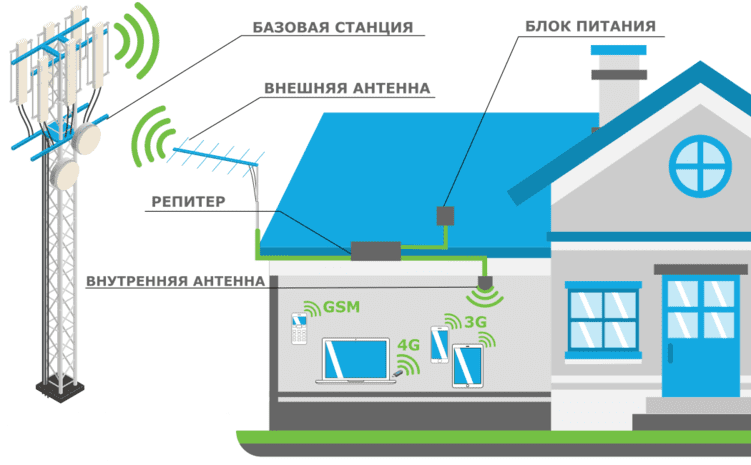
What is included?
The kit includes the repeater itself, outdoor and indoor antennas, cable assembly (wires connecting the repeater to the external and internal antennas), a repeater power supply, fasteners and detailed installation and operation instructions for the kit. In addition, you can purchase brackets and masts for attaching a street antenna to a building wall, as well as lightning protection, which prevents damage to equipment from electrostatic voltage that occurs during a thunderstorm.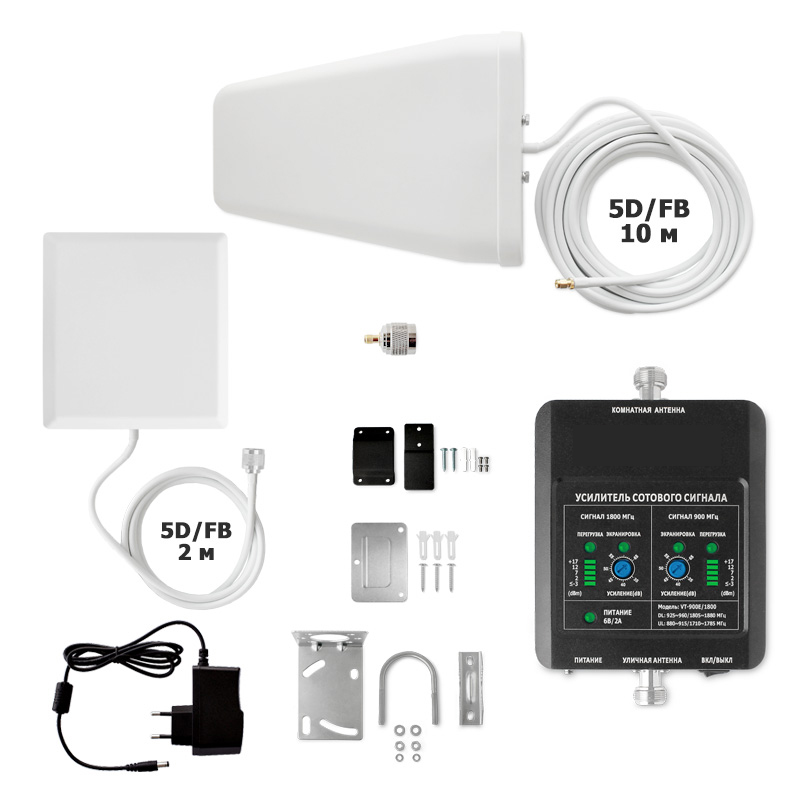 Now that we understand what a ready-made kit for enhancing cellular communications is all about, let's decide where and why we will amplify the signal. It is important. Indeed, in order to most effectively solve the problem of improving poor communication, you need to take into account existing conditions and the result that you expect from the amplifier.
Now that we understand what a ready-made kit for enhancing cellular communications is all about, let's decide where and why we will amplify the signal. It is important. Indeed, in order to most effectively solve the problem of improving poor communication, you need to take into account existing conditions and the result that you expect from the amplifier.The amplification of the cellular signal in the country
As a rule, in rural areas towers of mobile operators are located far from each other. They are placed first of all close to more or less large settlements. If your house is located at a considerable distance from the towers of base stations, then, in this case, it is preferable to choose a kit with a repeater that works at low frequencies, for example 800 and 900 MHz. These frequencies are spread over large distances, which means that there is the possibility of stable reception and transmission of a signal from the base station to the receiving antenna and vice versa. The frequency of 900 MHz is still the most common in the field of cellular communications. Almost all mobile operators work on it. An exception is Tele2, this operator does not use this range in the territory of the Russian Federation.The frequency of 800 MHz is supported by major mobile operators and allows you to transmit a signal of high-speed mobile Internet in the standard LTE-800 (4G) over a distance of 13 kilometers.In the frequency range of 900 MHz, two communication standards operate - GSM-900 (2G) and UMTS-900 (3G). This means that using a cellular amplifier with a working frequency of 900 MHz, you can improve not only voice communication, but also mobile Internet in the 3G standard. However, it must be borne in mind that not all mobile operators support Internet transmission at this frequency.If your house is not very far from the village, there is the opportunity to "catch" a higher frequency, for example, 1800 MHz or 2100 MHz. Then full-fledged high-speed Internet and voice communication in 3G standard (UMTS-2100), as well as high-speed Internet in LTE-1800 standard (4G) and voice communication in GSM-1800 (2G) standard with a wider bandwidth become available.In the 3G and 4G standards, modern voice communication works on smartphones. They automatically select a higher frequency even when its signal is very weak. Hence the well-known problem of the disappearance of the interlocutor and interruption of communication. The device "clings" to a weak high-frequency signal, and when it is completely lost, it switches to a lower, but stable one.Old-style push-button telephones operate in the 2G standard in the frequency ranges GSM-900 and GSM-1800 and also prefer the upper frequency if available.Amplification of a cellular signal in an apartment
And if you need to amplify the signal in the apartment? Yes, even in a large city, where there are hundreds of base stations, you can remain without communication. This problem is relevant for residents of dense urban areas, owners of apartments on the upper floors, in new buildings, in houses with thick walls, in the yards of "wells", etc. Acommunication strengthening kit for the apartment will help here. The peculiarity of the urban kit in a compact outdoor antenna and higher operating frequencies, although many kits for giving can also be successfully used in the city. But, since in a large city there are GSM, 3G and 4G communication standards at high frequencies, it is reasonable to choose an amplifier that supports these standards. These are GSM-1800, UMTS-2100 (3G) and LTE-2600 (4G).Above, we described the two most common cases when you need to amplify a signal. But there is no such repeater that is ideal for a summer residence, but completely useless in the city. Most kits are universal. With their help, you can amplify the signal in a country house, in the country, in the office, garage or apartment. It’s just that there are kits with parameters that are more suitable for rural areas, where the distance to the towers of base stations is greater, and there are those that are more relevant to use in the city. To choose the kit that best suits your conditions, you need to determine in which standard and at what frequency the cellular signal is transmitted in the area of your home.Frequency Range Definition
Consider how you can independently determine the frequency range and other parameters. To do this, you can use free applications for smartphones, such as Network Cell Info Lite or Cell Towers, Latitude. Measurements will need to be carried out in different connection modes - 4G, 3G, 2G. To do this, in the settings of the smartphone, you need to consistently switch the type of network and check the readings from the application.Let's consider an example for Android using the Cellular Towers, Locator application:Go to Phone settings and select Network and Internet.Then select Mobile network.Go to Advanced settings.Choose Preferred network type.You can do this from the settings of the application itself: click on the menu (three vertical dots in the upper right corner of the screen), select Network settings = >> Advanced settings = >> Preferred network typeAlso in the drop-down menu, you can switch to another SIM card, by selecting “Switch to SIM2”,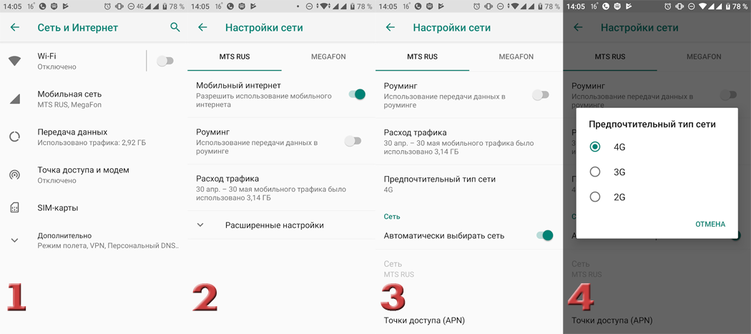 alternately choosing communication modes, check what type of connection the application shows.
alternately choosing communication modes, check what type of connection the application shows.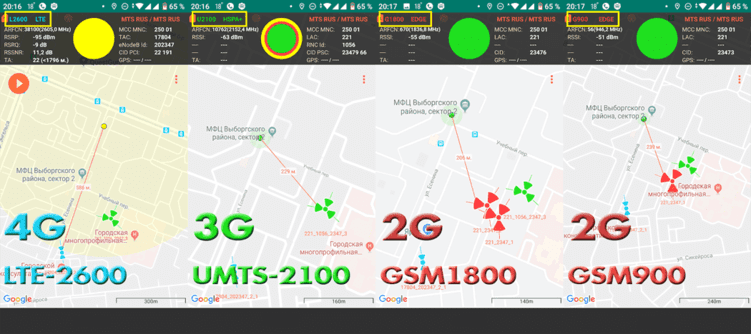 In the upper left corner of the screen (circled by a yellow frame), the frequency range designation is displayed. A little lower you can see the signal level in dB. The higher the number, the weaker the signal! A good signal is considered to be -100 dB. Our task is to select a priority frequency range from each standard that goes inside the room and strengthen it. Do not rush into determining the type of connection, it is better to wait a minute or two until the device selects a priority frequency. For example, the G900 can be replaced by the G1800. This means that the frequency of 1800 MHz is present in the room, and even if its signal is weaker than that of 900 MHz, the phone will prefer to work at a higher frequency.The Network Cell Info Lite application is convenient in that it visually shows the level of the incoming signal. The start section "Sensors" shows a scale similar to a speedometer. It allows you to evaluate the quality of communication in a particular standard. If the arrow is in the green zone, then the signal is good, it is not necessary to amplify it.
In the upper left corner of the screen (circled by a yellow frame), the frequency range designation is displayed. A little lower you can see the signal level in dB. The higher the number, the weaker the signal! A good signal is considered to be -100 dB. Our task is to select a priority frequency range from each standard that goes inside the room and strengthen it. Do not rush into determining the type of connection, it is better to wait a minute or two until the device selects a priority frequency. For example, the G900 can be replaced by the G1800. This means that the frequency of 1800 MHz is present in the room, and even if its signal is weaker than that of 900 MHz, the phone will prefer to work at a higher frequency.The Network Cell Info Lite application is convenient in that it visually shows the level of the incoming signal. The start section "Sensors" shows a scale similar to a speedometer. It allows you to evaluate the quality of communication in a particular standard. If the arrow is in the green zone, then the signal is good, it is not necessary to amplify it. Network Cell does not show the frequency range in megahertz, but it can be found from the Band indicator. At the bottom of the page is a table of correspondence between the Band values and the frequency range in MHz. For example, Band 1 is 2100 MHz in the UMTS (3G) standard.The advantage of these applications is that they show the location of the towers of base stations. This will be needed when installing an external antenna. It will need to be oriented in the direction of the base station. Moreover, if there are obstacles between the point where the antenna is located and the base station, such as tall trees, buildings, it is better to direct the antenna into the space free from obstacles.So, having determined the frequency ranges on which the signal is transmitted in the area of your home, you can proceed to the selection of the kit, but we will dwell on a parameter such as signal amplification power.
Network Cell does not show the frequency range in megahertz, but it can be found from the Band indicator. At the bottom of the page is a table of correspondence between the Band values and the frequency range in MHz. For example, Band 1 is 2100 MHz in the UMTS (3G) standard.The advantage of these applications is that they show the location of the towers of base stations. This will be needed when installing an external antenna. It will need to be oriented in the direction of the base station. Moreover, if there are obstacles between the point where the antenna is located and the base station, such as tall trees, buildings, it is better to direct the antenna into the space free from obstacles.So, having determined the frequency ranges on which the signal is transmitted in the area of your home, you can proceed to the selection of the kit, but we will dwell on a parameter such as signal amplification power.Maximum kit gain
You can pay attention to the fact that the gain in dB for different repeaters is not very different (60-65-70 dB), while the area of action may vary significantly. In fact, the dependence here is not linear, but logarithmic. Every + 3-5 dB doubles the power. Therefore, a kit with a maximum gain of 83 dB can cover an area twice as large as a kit with a gain of 78 dB. The characteristics of each repeater and the finished kit indicate the maximum area of action in the premises. But not only the size of the room affects the choice of amplifier power. A very weak input signal can lead to the choice of a more powerful amplifier that can cover a larger area than necessary.Kit installation
We recommend starting with the installation of a street antenna. You have already determined the direction to the nearest base station using the mobile application. Now you need to choose a place to mount the antenna to the wall. If we are talking about a country house, then it is advisable to fix the antenna higher. So, there will be less interference on the signal propagation path. In the case when there is high vegetation around the house, you can install an external antenna on a special mast. When installing the communication enhancement kit in an apartment or office, an external antenna is usually mounted on the wall next to the window or on the frame of the window itself.Then you need to get the cable from the external antenna into the room. This can be done by drilling a hole in the wall or in the floor if the antenna is installed on the roof.Choose a place for mounting the repeater. It can be mounted on a wall or furniture using the hardware provided. It is necessary that there was a 220 volt outlet nearby to connect the repeater to the network.Then we connect the indoor antenna, and mount it either on the wall or on the ceiling, as long as the cable is enough. The cable length of the internal antenna is usually 2 meters. If for some reason you need to install the antenna further from the repeater, you can additionally purchase a separate cable assembly. Embedding schemes will be given below.An important point when choosing a place to install antennas. The external and internal antennas should be located as far apart as possible. This is necessary so that the signal does not loop back. This is when the signal from the internal antenna is captured by the external. As a result, interference occurs and the system ceases to operate efficiently. If the indoor antenna is directional, it should not be directed in the direction where the outdoor antenna is installed.Connection options for kit components
Standard diagram: If you need to extend the indoor antenna cable:
If you need to extend the indoor antenna cable: If you need to extend the outdoor antenna cable:
If you need to extend the outdoor antenna cable:
Gain power and signal level in dB
You probably could already pay attention to the fact that the gain in dB at different repeaters is not very different. 60-65-70 dB. In fact, the dependence here is not linear, but logarithmic. Every + 3-5 dB doubles the power. Therefore, a kit with a maximum gain of 83 dB can cover an area twice as large as a kit with a gain of 78 dB.Important! Do not turn on the repeater without connected antennas! In this case, the repeater may fail.What is the use of installing a repeater? It's important to know!
In addition to providing the premises with stable cellular communications, a repeater kit reduces the level of microwave radiation from cell phones and other mobile devices. It is known that the mobile phone itself is a source of electromagnetic radiation. The weaker the incoming signal from the base station, the stronger the phone begins to emit, trying to keep in touch with the tower of the mobile operator. The radiation level in conditions of poor reception can reach 1.5-2 W, while the most powerful repeater has a radiation power of not more than 0.2 W for each frequency range, that is, 10 times lower!After installing the communication enhancement kit, mobile devices find themselves in favorable conditions for receiving a signal and reduce the level of their own radiation. It decreases tens of times and does not exceed 0.02 watts. It is not difficult to calculate that the total radiation level of the system will be significantly lower than the initial one, when the phone in search of a network worked at maximum power. In addition, you need to understand that during the conversation we keep the phone in close proximity to the head, and the repeater antenna is at a distance of several meters. The electromagnetic effect decreases significantly with increasing distance from the source of EM waves.From the foregoing, it can be concluded that the communication enhancement kit reduces the negative impact of a cell phone and other mobile devices.Good to know
Compliance with communication standards and frequency ranges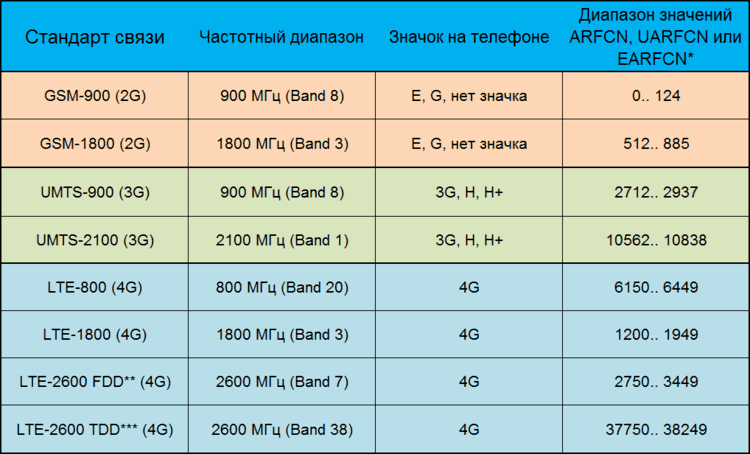 * - Absolute radio frequency range.
* - Absolute radio frequency range.
** - FDD (Frequency Division Duplex) uses DL / UL frequency separation of channels, which makes it possible to amplify this signal with an active amplifier (repeater).
*** - TDD (Time Division Duplex) uses DL / UL time division of channels, which makes it impossible to amplify this signal with an active amplifier (repeater).4G LTE frequency ranges of Russian telecom operators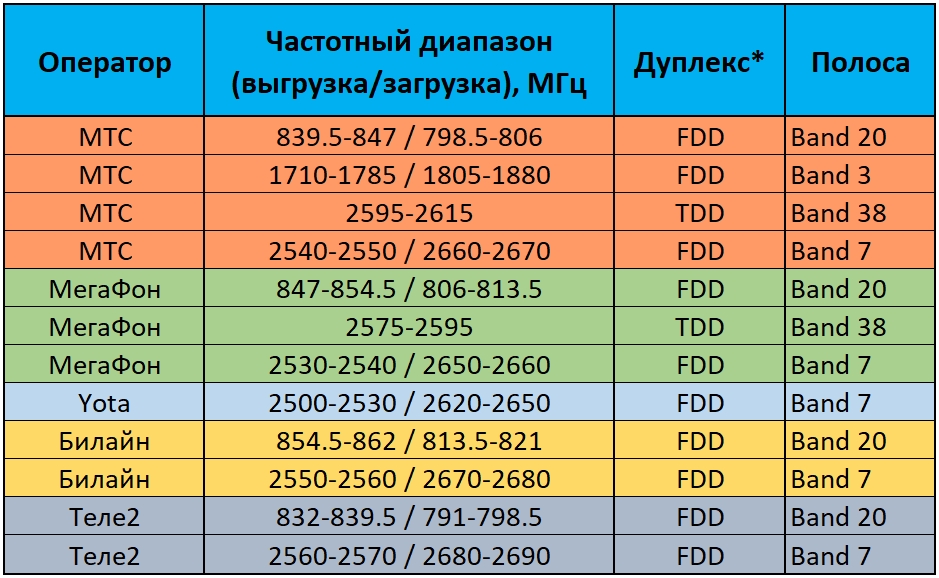 * - Two-way communication method using transceivers.
* - Two-way communication method using transceivers. Source: https://habr.com/ru/post/undefined/
All Articles